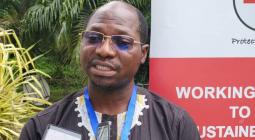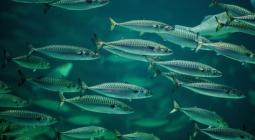This pristine lake has endured for 2m years. Why are its fish in crisis?
In one of the world’s oldest lakes, Hovsgol grayling, a species found only in these azure waters in Mongolia, are struggling to survive
Pine-studded mountains and snow-capped hills fringe Mongolia’s ancient Lake Hovsgol. Wild flowers cascade down its steep banks, and its forests harbour wolves, moose and elk. Despite its remoteness, small towns, tourist lodges and pastoralists’ gers – the traditional Mongolian circular felt tents – are sprinkled along the shore, along with herds of sheep, goats and yaks.
Located in north Mongolia, a few miles from Russia, Lake Hovsgol is the country’s deepest and largest lake by volume. It is known locally as the Blue Pearl for its translucent azure water, and is considered one of the most pristine lakes in the world. It is also one of the oldest, formed more than 2m years ago.
The lake’s remoteness, protected status as a national park and low human population density have preserved its character and ecosystems for centuries – but now climate breakdown threatens the lake and the people who rely on it. Since 1940, air temperatures in Mongolia have increased by more than 2C (3.6F), more than double the global average, making it one of the countries most severely affected by the climate crisis.
And just as Mongolia’s herders and livestock are struggling to cope with rising temperatures above ground, so are the fish that live in Lake Hovsgol.
"When the grayling head up the tributaries, they’re vulnerable, they’re easy to catch Olaf Jensen
Lake Hovsgol is home to 10 fish species, including the endangered and endemic Hovsgol grayling (Thymallus nigrescens). Long, thin and unassuming most of the year, the silver bodies of males turn opalescent blue during the spawning season.
For the past 15 years, Mongolian and US scientists have been working to understand the impact of the climate crisis on Hovsgol grayling. What they have found is concerning. As a cold-water species, the fish are particularly vulnerable to temperature increases, explains Mendsaikhan Bud, an ichthyologist at the Mongolian Academy of Sciences.
The tributary streams used by Hovsgol grayling for spawning are also drying up. “They no longer have water in them during the spring spawning season,” says Olaf Jensen, an associate professor at the University of Wisconsin-Madison. Nearly 80% of the 96 streams that once flowed into Lake Hovsgol are dry during the key months when the fish migrate.
With only about 20% of streams remaining, the fish that use them to spawn each spring are vulnerable. “Overfishing is a major threat,” says Bud. Herders around Lake Hovsgol have long relied on subsistence fishing to carry them through each spring – no one wants to slaughter skinny sheep at the end of winter.
Spawning grayling are the easiest fish to catch at that time of year, by stretching gill nets across the streams. “When the grayling head up the tributaries, they’re accessible, they’re vulnerable, they’re easy to catch,” says Jensen. While gill net fishing is illegal in the national park, subsistence fishing is allowed during the spring spawning season.
Although subsistence-level fish harvests may have worked historically, climate breakdown and overgrazing have disrupted the balance. Around Lake Hovsgol, the number of storms has nearly doubled since 1980, resulting in more flooding and topsoil erosion. At the same time, grasslands throughout Mongolia have become severely overgrazed, an issue with historical roots in the breakup of the former Soviet Union in the 1990s. These factors have made herding much harder.
To cope with these challenges, herders have turned to fishing in the national park, not only as a source of food, but also for additional income. “More and more people seem to be supplementing their income through a bit of fishing and selling those fish,” Jensen says.
Hovsgol grayling can now be found in many markets around the lake, says Bud. An estimated 33,000 fish are taken annually from the Har Us mineral spring alone, a popular tributary for tourism and fishing.
The disappearing tributaries and increased fishing pressure are having an impact: when Bud and Jensen interviewed local herders, nearly all said Hovsgol grayling populations had decreased dramatically.
The average size of many fish species in the lake has also decreased. This could be driven by overfishing, the elimination of larger species, or the higher energy demands placed on fish as temperatures rise, resulting in fish with fewer internal resources to devote to growth. In a global analysis of thousands of animal and plant species in 2023, scientists found that many fish species were shrinking – an effect they attributed to the climate crisis.
Safeguarding the Hovsgol grayling is vital for maintaining the lake’s fragile ecosystem and sustaining the subsistence traditions of local people. Yet protection is challenging. While enforcement against illegal fishing occurs outside the spring spawning season, there are few rangers to monitor such a large area.
Enforcement also stops after the fish are caught and offered for sale. Gill nets are cheap and easy to obtain, so confiscation has minimal impact. The laws and regulations protecting the fish need to be improved, says Bud.
Still, all hope is not lost for Hovsgol grayling. Populations have been found to spawn not only in tributary streams in spring but also along the lake’s shore in summer, “something that gives it some resilience to the things happening because of climate change”, notes Jensen.
Even if additional tributaries dry up or spring fishing pressure continues in the streams, fish that spawn later in the lake may be spared.
Cover photo: Goats, horses, and yaks graze along the shore of Lake Hovsgol. Overgrazing and more frequent storms are degrading pastures used by herders, meaning many are turning to fishing to supplement their income






